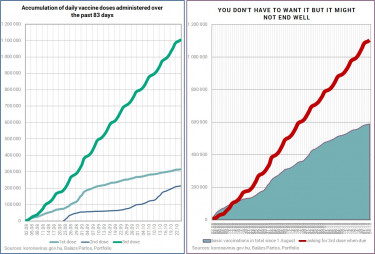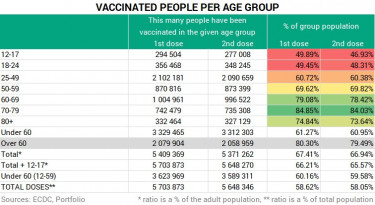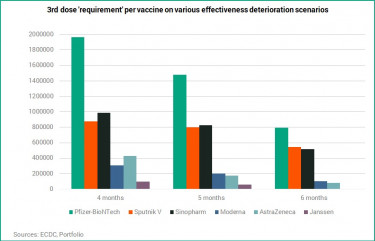Everything you did not want to know about third doses of Covid vaccines

Let's kick off with a rather cryptic graph. To decipher its meaning in full please read on.

A word of warning
When we talk about diminishing / waning / decreasing vaccine effectiveness / efficiency / efficacy, it refers to the vaccine's weakened capacity to protect the inoculated person FROM INFECTION. This must not be mixed up with diminished efficacy to prevent severe disease or death.
A pair of new real-world COVID-19 vaccine studies show good protection against the Delta (B1617.2) variant, one from Scotland finding higher than 90% effectiveness in preventing death in adults and the other showing 93% efficacy against symptomatic infection in Israeli adolescents after the second dose.
Vaccine effectiveness wanes over time
As daily new confirmed COVID-19 cases flare up, not just locally but globally, experts urge the deployment of other risk-mitigating measures, such as mask-wearing, social distancing, and the use of vaccination certificates among other things.
Studies show that the effectiveness of COVID-19 shots against infection does wane, while they remain an excellent protection against severe symptoms and death. Consequently, third or booster doses are recommended, primarily for vulnerable groups.
Hungary was the first in Europe that authorised third doses of COVID-19 vaccines and they began administering them on 2 August this year. That was its second maverick manoeuvre of the government that should be applauded. The first was the procurement of vaccines from the East (Russia’s Sputnik V and China’s Sinopharm) that had no emergency authorisation either by the World Health Organisations (WHO) or the European Medicines Agency (EMA).
At first, the country excelled at the rate of vaccinations, but then the rest of (Western) Europe caught up with it and gradually surpassed it. It’s neighbours (apart from Austria) are still behind, though, some by quite a lot, and the spread of coronavirus there (e.g. Romania) testify that it was a grave mistake.

Vaccination snapshot in Hungary
While third doses appear to be very much in demand in Hungary, and 1.12 million doses have been administered since they were made available, the number of people that have chosen to swim in the treacherous waters of coronavirus without a life jacket has been decreasing at a snail’s pace. With a weekly average uptake of less than 29,000 first and slightly more than 23,000 second doses it is fairly safe to expect coverage in the country of 9.73 million people to remain largely unchanged in the short term.
In the meantime, third doses are in relatively high demand, with a weekly average of 92,000 doses administered.


According to data by the European Centre for Disease Prevention and Control (ECDC),
more than 40% of the entire population (9.73 million) have not received a single dose of any COVID-19 vaccine in Hungary.
The same ratio in the 60+ age group is around 20%, while around 35% of the adult population plus those in the 12-17 age group are also not inoculated against SARS-CoV-2. See more details in the tables below (data are up to Week 41 that ended on 17 October).


Lack of vital data in Hungary
There are various studies (in the U.S., the UK, Israel, etc.) showing that the effectiveness of vaccines (all of them to varying degrees) wane over time.
Due to the lack of essential data, it is difficult to assess the situation in Hungary in this respect. Authorities do not disclose information about the vaccination status of those that officially contract COVID-19, that are subsequently hospitalised, end up on ventilator and eventually in the morgue.
We also have absolutely no information on third doses other than their suspiciously round number published by the official government website on weekdays.
We have inquired at the National Public Health Centre (NNK) but have not received a response yet. No surprise there.
It is easy to see that without these pieces of vital data it makes little to no sense to delve into effectiveness issues and come up with estimates on the actual risks related to diminishing vaccine effectiveness faced by the Hungarian population. (If you want to read upon the issue, here’s an excellent article.)
How much vaccine effectiveness wanes?
The waning effectiveness of various COVID-19 vaccines and the impact of third doses on antibody levels was the subject of a recent trial by Hungarian company Videoton, which recommended getting a third jab, particularly for elderly people vaccinated with China’s Sinopharm. Recipients of Sinopharm, particularly those over 60 years of age a lot of subjects had extremely low antibody levels. In fact, some had no protection whatsoever, ie. either antibodies or T-cells. Following a third dose of Pfizer-BioNTech's vaccine their antibody level skyrocketed, though.
Here are a couple of charts on the vaccination status of the 60+ age group in Hungary.


The results of a substantially larger new trial (not even in the same league as that of Videoton) were published recently in The Lancet. It follows 3.4 million people who were fully vaccinated with Pfizer’s jab.
The following graph shows vaccine effectiveness over time by age. Everybody’s antibodies wane at a similar pace, but people over 65 start from a lower base. Importantly, this is just effectiveness against infection.

The second graph shows vaccine effectiveness against hospitalisation and death by variant – the real outcomes we should care about. The good news is that no waning was detected in any age group. Effectiveness holds at about 93%.

The third graph shows vaccine effectiveness over time by variant. Red is Delta, the only variant that really matters at the moment.
After four months, effectiveness dropped to 53% from 93%.

If we accept that the effectiveness of all vaccines wane over time, we should not have a problem accepting that third doses could help restore and boost effectiveness against infection.
A booster dose of the COVID-19 vaccine developed by Pfizer and German partner BioNTech restored efficacy to 95.6% against the virus, including the Delta variant, according to the first results from a massive trial with more than 10,000 participants the companies presented last week.
On 5 October, the European Union's drugs regulator (EMA) said people with weakened immune systems should get a third dose of a COVID-19 vaccine from Pfizer-BioNTech or Moderna, but said member states should decide themselves whether they make booster shots available for the wider population.
3rd doses in three scenarios
As noted before, we could (and perhaps should) calculate how many people in which age group are due for a third dose after receiving two doses of what vaccine, but… it really makes no sense without having much more information on the recipients of 3rd doses.
Yet, we can make a rough estimate under various scenarios on how many people in total could register for a 3rd dose.
These scenarios assume that vaccine effectiveness starts to wane (i) 4 months, (ii) 5 months, and (iii) 6 months after full vaccination is reached.
We also provide a breakdown by vaccines but not by age groups (this time).
There are two more ‘groups’ we need to add to those that had both COVID-19 vaccine doses (or just one if it was Johnson & Johnson’s single dose Janssen vaccine), namely the unvaccinated adult population and those in the 12-17 age group that are eligible for vaccines but have not requested the shots. (It’s not a widely known fact that Moderna shots have also been given to those between 12 and 17 since 2 August. Authorities said earlier that adolescents would receive only Pfizer-BioNtech jabs. Only 417 first and 341 second doses of Moderna’s vaccine have been administered so far, though.)
- 4 months after full vaccination
As you can see, the vaccination situation becomes rather worrying under the first scenario in which we assume that vaccine effectiveness starts to wane four months after the second dose. In that case, we have more than 6.5 million people either without any vaccination (cc. 3 mn) or with diminished immunity to infection (cc. 3.6 mn).
- 5 months after full vaccination
Under the second scenario (vaccine effectiveness starts to wane after five months), there would currently be some 5.4 million people in the country either unvaccinated or with diminished protection from infection.
- 6 months after full vaccination
In the best-case scenario (lower immunity to infection starts after six months), there would still be 3.9 million people with no or diminished immunity to infection, although ‘only’ about 940,000 of them would need only a third dose to fix the problem.


Finally, just a theoretical calculation regarding the most vulnerable group, those over 60 years of age.
Assuming that vaccine effectiveness starts to wane after six months, and assuming that no one in the 60+ age group has received a third dose up to date (it’s a wild assumption, but we just don’t know), this is how many recipients of each type of vaccine should get their third jab pronto:
- AstraZeneca: 1,888
- Sinopharm: 488,988
- Pfizer-BioNTech: 531,909
- Janssen: 0
- Moderna: 69,699
- Sputnik V: 224,052
Note that this is the best-case scenario. The respective figures with vaccine effectiveness down four months after full vaccination are more daunting.
- AstraZeneca: 156,399
- Sinopharm: 550,840
- Pfizer-BioNTech: 841,900
- Janssen: 16,021
- Moderna: 124,637
- Sputnik V: 247,494
We are aware that it is a bold and even improbable assumption that no one in the 60+ age group got their third jab. To remedy this "folly" we have made another absurd assumption that every third shot was administered to people over 60 years of age.
As you can see in the table below, the situation looks a lot less daunting on all three scenarios, but it still does not look reassuring. Especially in light of the stalled vaccination campaign.


Conclusion
If you have gotten this far, congrats. If there was a purpose behind crunching all those numbers, coming up with these good-looking tables and graphs, and finally writing this article, it was to raise awareness of the importance of vaccines, particularly of third or booster doses.
However, we do not have the illusion that vaccines will do the trick, because they certainly will not. Not if they are the only line of defense. There is evidence to that all over the world.
Vaccination coverage of 60% is bupkis. It could be higher, a lot higher. Hungary has received nearly 20.5 million doses of COVID-19 vaccines, and administered about 12.8 million of them, so there's plenty left to go around.
The government could have and should have adopted a more successful strategy to persuade people to get their jabs, but this was what we had to work with. All of us have a brain, and if we don't use it, we can also thank ourselves for this situation.
This 'fourth wave' of the pandemic cannot be avoided. It's too late for that. It was too late already two months ago. If testing had been cranked up in the summer and if there had been restriction measures in place in time... Ifs and buts... It's water under the bridge now. It could even be a fabulous scene if it was not for the rising number of bodies floating down river.
Cover photo: Getty Images







